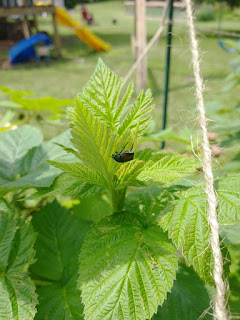Bill Hutchison, Suzanne Wold-Burkness, Eric Burkness, UMN Extension IPM Program, Dept. of Entomology, UMN, St. Paul campus
The good news is that the JB counts remained very low at Hastings and Forest Lake. JB counts can also be viewed 24/7 at the new FruitEdge web page: https://www.fruitedge.umn.edu/pests/jb/jbtraps
As noted on this web page, we also provide 2019 JB trap catch data for these same locations, for comparison. In 2019, JB adult populations did not begin to increase substantially until July 4th. More details regarding JB management in fruit crops will be reviewed in upcoming issues of the newsletter, as well as research updates.
Several fruit growers are increasingly using various “fine mesh” nettings to place over fruit crops in open fields or high-tunnels. In high tunnels, this can be used to provide 100% fine mesh coverage, or the mesh netting can be added just to the sides and ends of the tunnels, with regular high tunnel plastic over the top. In these situations, using fall raspberries and grapes, our research has found that JB is another key pest that can be managed quite well using this “Physical Exclusion” approach.
Even for high tunnels with plastic over the top and open ends (no mesh), JB adult behavior is influenced such that the adult beetles do not appear to be attracted to fruit crops growing under the plastic. This may be due to the increased temperature and/or other micro-climate changes in the tunnels. More on this topic will be shared in future issues of the newsletter.
An overview of JB management in fruit crops, via Michigan State, is available at: https://www.canr.msu.edu/news/managing_japanese_beetles_in_fruit_crops
SWD fly counts are available at the FruitEdge SWD page at: https://www.fruitedge.umn.edu/swdtrap. SWD trap catch numbers are usually updated on Tuesdays or by Wednesday noon each week; trap catch comparisons are also available for 2018-2019.
For more information on SWD traps, or how to build your own using apple-cider vinegar (ACV) traps, see: https://www.fruitedge.umn.edu/swdbiology.
Note: For annually updated insecticide control options, refer to the annually revised “Midwest Fruit Pest Management Guide”, available at: https://ag.purdue.edu/hla/hort/pages/sfg_sprayguide.aspx
This guide is produced by UMN Extension and cooperating Midwest state Extension Specialists.
For all pesticides, it is essential to read the label prior to use, and to closely follow the Re-entry Interval (REI) and Post-harvest Interval (PHI) requirements.
Japanese Beetle (JB)
During the past week JB adult counts increased dramatically at two of our southern MN trap sites. Compared to only 1-3 JB/trap last week, JB numbers increased to an average of 410 JB/trap/week at Rosemount (Dakota Co.), and to 230 JB/trap/week at the UMN Horticultural Research Center near Chanhassen (Carver Co.).The good news is that the JB counts remained very low at Hastings and Forest Lake. JB counts can also be viewed 24/7 at the new FruitEdge web page: https://www.fruitedge.umn.edu/pests/jb/jbtraps
 |
| A Japanese beetles on a raspberry plant. Photo: Annie Klodd, UMN. |
As noted on this web page, we also provide 2019 JB trap catch data for these same locations, for comparison. In 2019, JB adult populations did not begin to increase substantially until July 4th. More details regarding JB management in fruit crops will be reviewed in upcoming issues of the newsletter, as well as research updates.
One new key JB management update:
 |
| Fine mesh "hail netting" covering rows of high density apple trees at Pine Tree Apple Orchard, June 2, 2020. Photo: Annie Klodd. |
Several fruit growers are increasingly using various “fine mesh” nettings to place over fruit crops in open fields or high-tunnels. In high tunnels, this can be used to provide 100% fine mesh coverage, or the mesh netting can be added just to the sides and ends of the tunnels, with regular high tunnel plastic over the top. In these situations, using fall raspberries and grapes, our research has found that JB is another key pest that can be managed quite well using this “Physical Exclusion” approach.
Even for high tunnels with plastic over the top and open ends (no mesh), JB adult behavior is influenced such that the adult beetles do not appear to be attracted to fruit crops growing under the plastic. This may be due to the increased temperature and/or other micro-climate changes in the tunnels. More on this topic will be shared in future issues of the newsletter.
An overview of JB management in fruit crops, via Michigan State, is available at: https://www.canr.msu.edu/news/managing_japanese_beetles_in_fruit_crops
 |
| Japanese beetles. Photo: Jeff Hahn, UMN Extension, Dept. of Entomology |
Spotted Wing Drosophila (SWD)
Adult SWD captures remained low (<2 adults/trap/week), with the exception of Rosemount where adult flies were up to 6/trap/week. The heat wave forecast today and the next 4 days, should help suppress SWD populations, as SWD adults do not like the heat (>85F), especially in open fruit canopies; during the day, SWD will retreat to nearby forest, tree-lines near fields, where possible.SWD fly counts are available at the FruitEdge SWD page at: https://www.fruitedge.umn.edu/swdtrap. SWD trap catch numbers are usually updated on Tuesdays or by Wednesday noon each week; trap catch comparisons are also available for 2018-2019.
 |
| SWD female (left), with close-up view of ovipositor (for egg-lay), and male (right) with characteristic dark spots on each wing (C. Guédot, Univ. of Wisconsin). |
For more information on SWD traps, or how to build your own using apple-cider vinegar (ACV) traps, see: https://www.fruitedge.umn.edu/swdbiology.
Note: For annually updated insecticide control options, refer to the annually revised “Midwest Fruit Pest Management Guide”, available at: https://ag.purdue.edu/hla/hort/pages/sfg_sprayguide.aspx
This guide is produced by UMN Extension and cooperating Midwest state Extension Specialists.
For all pesticides, it is essential to read the label prior to use, and to closely follow the Re-entry Interval (REI) and Post-harvest Interval (PHI) requirements.
Comments
Post a Comment